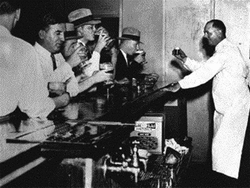
Prohibition - the period (1920–33) when the Eighteenth Amendment was in force and alcoholic beverages could not legally be manufactured, transported, or sold in the U.S. What was used to bring crime rates down resulted, ironically, in the sky rocketing of gang activity and other criminal offences. Initially, a number of Americans endorsed the “great experiment” but rapidly grew disenchanted with it. The cost of drinks skyrocketed. Most of the liquor sold was poor quality or watered down, so people would add ginger ale, tonic water, or fruit juices – the birth of the cocktail. People were not willing to stop drinking, which resulted in the term “speakeasy”. The word “speakeasy” derives from a bartender’s term: people were supposed to “speak easy” when at a bar, so as not to draw any suspicion towards buying alcohol by looking nervous or talking quickly. Prohibition jump-started the Jazz Age.
Speakeasies, or “Blind Pigs”, sold illegal booze during Prohibition. Speakeasies hid in plain sight. They were in almost every community, serving all the illegal alcohol their customers wanted. They were similar to today’s clubs, featuring singing, jazz, and gambling. A password was required at the door to gain access. Slang words used for booze, to fool officials included:
•coffin varnish
•horse liniment
•tarantula juice
These “secret gin joints” were most common in New York, especially in between 45th and 52nd street on 5th and 6th avenues, where almost every single building contained illegal liquor. Manhattans “21” club was probably the most secure club, with four safety switches that could be used during a raid to short circuit and cut the access to all of the doors that contained alcohol.
To transport liquor to the speakeasies, they used hip flasks, false books, coconut shells, hot water bottles, and garden hoses. People stored the illegal liquor in carriages with babies perched on top and in carpenters’ aprons. There were even men caught hustling liquor over the border in boxes of eggs. They had drained the eggs of the original contents and refilled them with liquor. The hip flask, filled with "bootleg" whiskey and displayed openly, soon became a familiar symbol of the era. Every community of any size had their "speakeasies," where both imported and homemade alcohol could be purchased.
As songwriter Hoagy Carmichael put it, the 1920s came in "with a bang of bad booze, flappers with bare legs, jangled morals and wild weekends." According to novelist F. Scott Fitzgerald, during Prohibition, "The parties were bigger…the pace was faster…and the morals were looser."
These underground saloons did a booming business. Keeping them supplied was the occupation for many thousands of rumrunners, bootleggers, and beer barons, who were forced to work beyond the law. All too often, rivalries and differences of opinion resulted in open warfare and gangland murders. Thanks to wartime technology, they had new and deadly weapons at their disposal, such as hand grenades, handy for blowing up the competition, not-to-mention machine guns and faster getaway cars.
Inevitably most of the liquor traffic fell into the hands of gangsters, whose names we still know today. Alphonse "Scarface Al" Capone of Chicago was only the most notorious.
Speakeasies, or “Blind Pigs”, sold illegal booze during Prohibition. Speakeasies hid in plain sight. They were in almost every community, serving all the illegal alcohol their customers wanted. They were similar to today’s clubs, featuring singing, jazz, and gambling. A password was required at the door to gain access. Slang words used for booze, to fool officials included:
•coffin varnish
•horse liniment
•tarantula juice
These “secret gin joints” were most common in New York, especially in between 45th and 52nd street on 5th and 6th avenues, where almost every single building contained illegal liquor. Manhattans “21” club was probably the most secure club, with four safety switches that could be used during a raid to short circuit and cut the access to all of the doors that contained alcohol.
To transport liquor to the speakeasies, they used hip flasks, false books, coconut shells, hot water bottles, and garden hoses. People stored the illegal liquor in carriages with babies perched on top and in carpenters’ aprons. There were even men caught hustling liquor over the border in boxes of eggs. They had drained the eggs of the original contents and refilled them with liquor. The hip flask, filled with "bootleg" whiskey and displayed openly, soon became a familiar symbol of the era. Every community of any size had their "speakeasies," where both imported and homemade alcohol could be purchased.
As songwriter Hoagy Carmichael put it, the 1920s came in "with a bang of bad booze, flappers with bare legs, jangled morals and wild weekends." According to novelist F. Scott Fitzgerald, during Prohibition, "The parties were bigger…the pace was faster…and the morals were looser."
These underground saloons did a booming business. Keeping them supplied was the occupation for many thousands of rumrunners, bootleggers, and beer barons, who were forced to work beyond the law. All too often, rivalries and differences of opinion resulted in open warfare and gangland murders. Thanks to wartime technology, they had new and deadly weapons at their disposal, such as hand grenades, handy for blowing up the competition, not-to-mention machine guns and faster getaway cars.
Inevitably most of the liquor traffic fell into the hands of gangsters, whose names we still know today. Alphonse "Scarface Al" Capone of Chicago was only the most notorious.
 RSS Feed
RSS Feed